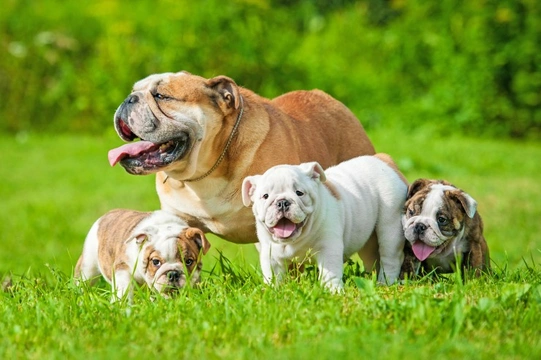
Eight top facts about the English bulldog
The English bulldog is one of the most instantly recognisable of all dog breeds, and one that is synonymous in many people’s minds with what it means to be British. Strong, tenacious and slow moving, the English bulldog is one of our oldest breeds, and one that is very popular all over the world with owners that have fallen for their undeniable but somewhat strange charms!
Whether you already own an English bulldog, are considering buying one or are just a fan of this old British dog breed, this article will share eight top facts and pieces of information that you may not already know about them. Read on to learn more.
They can’t swim
It is a common assumption made by many people that all dogs can swim, and while all dogs will automatically make swimming movements if placed into water, some will sink like a stone nonetheless!
The English bulldog is one such dog, due to the sheer size and weight of their heads and necks-they cannot keep their heads above water and breathe through their short, flat muzzles while propelling themselves along.
Care should be taken around the water with a bulldog, especially if you are not sure if they can paddle or not!
They need help to breed
Once again because of the width of the head and neck of the breed, English bulldog puppies require delivery by caesarean section in over 80% of cases, because the hips of the dam are too narrow to naturally deliver the pups.
This means that anyone planning to breed from their English bulldog will need to plan carefully for a caesarean delivery, and the cost of the delivery along with the fact that bulldogs usually have small litters means that bulldogs are often quite expensive to buy.
They are not very clever
When it comes to canine intelligence, the English bulldog really doesn’t excel… they are ranked last but one in the Coren list of canine intelligence, with only the Afghan hound coming in below them. This means that the bulldog tends to be rather ponderous when given commands, and may not respond very quickly, or without a few repetitions of the same command.
Generally, they will only be able to learn to respond to a few basic core commands, and so you should decide carefully what you want to teach them!
…Or very lively!
When you look at the short, stocky and muscular appearance of the bulldog and take into account the size of their heads and necks, it is understandable that they are definitely not the most athletic of dog breeds, and they spend a lot of time sleeping, lazing around and doing generally not very much at all!
While they need regular daily walks like all dogs do, they will be happy with a half hour stroll every day, and will be quite likely to simply sit down and refuse to walk any further when they’ve had enough!
They can be very stubborn
As mentioned, when an English bulldog decides that they have had enough, don’t want to do something or don’t really feel as if they have enough of an incentive to do something that you ask them to do, they are quite likely to just refuse to do it, and won’t take any convincing!
However, they will rarely become aggressive or defensive about it-they just won’t cooperate!
Lots of breeds exist thanks to the English bulldog
The English bulldog has been an integral part of a great many other breeds that we know and recognise today, and most of the bull-type breeds in existence owe a large part of their ancestry to the English bulldog.
The French bulldog, Boston terrier and various other breeds all exist today because the English bulldog came first!
The English bulldog was initially bred for fighting
The strength, stubbornness and instincts of the English bulldog means that they were originally prized for their fighting prowess, and used for fighting with other dogs and also, other so-called sports that are now illegal such as bull baiting.
Fighting roles first led to the popularity of bulldogs and their spread across the UK, but once such sports fell out of fashion and eventually became illegal, the bulldog’s calm, loving demeanour meant that making the transition to domestic pets rather than fighting dogs came naturally.
Today’s bulldogs look very different to their ancestors
The English bulldogs of today bears very little resemblance to their original ancestors, and selective breeding in order to achieve certain traits and a specific look has led to the appearance that we associate with today’s dogs; and this has done the breed itself no favours.
The short, heavy and muscular body of the dogs, their exaggeratedly flat faces and wide heads and bodies all occurred due to selective breeding, and can cause such dogs to be uncomfortable and even suffer from health issues.
Exaggerations in the English bulldog are now discouraged, however, the breed standard for historical bulldogs dictated a much taller, leaner and less flat-faced type than we see today!



